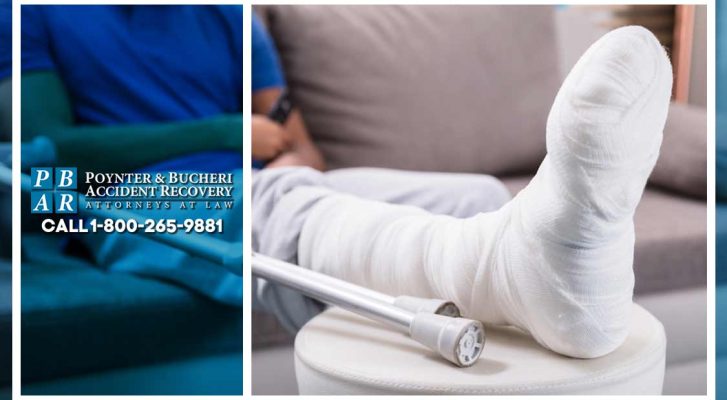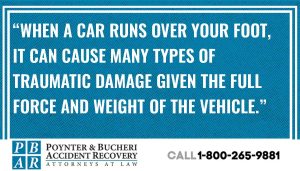
What to Do if Your Foot Gets Run Over by a Car

Having your foot run over by a car can result in severe and potentially disabling injuries. If you experience this traumatic event, it is crucial to take immediate action to protect your health and legal rights. This article provides an overview of common foot injuries from car accidents and outlines the steps you need to take after such a crash.
Common Causes of a Pedestrian Auto Accident
Before discussing the details of car accident foot injuries, let’s go over common causes of pedestrian accidents.
In Indiana, pedestrian accidents leading to foot injuries are often caused by hazardous conditions and driver errors:
Failing to Yield Right-of-Way: Drivers must respect crosswalks and stop for pedestrians, allowing them to cross safely.
Speeding: Higher speeds dramatically reduce a driver’s ability to stop in time when someone crosses their path, possibly leading to a car accident.
Distracted Driving: Texting, talking on cell phones, adjusting music or navigation apps – drivers distracted by electronics and other activities are less aware of pedestrians. This makes getting into a car accident a lot more likely.
Impaired Driving: Alcohol and drug impairment slows reaction times and impacts judgment, making it very difficult for motorists to respond appropriately to pedestrians, leading to severe injuries.
By being aware of these common causes of pedestrian collisions, we can work together to prevent such needless tragedies.
Hoosiers deserve safe walking routes free of the threat of careless, reckless, or impaired drivers. Pedestrians and motorists alike must make smart choices focused on safety for all.
Potential Foot Injuries from Car Accidents

When a car runs over your foot, it can cause many types of traumatic damage given the full force and weight of the vehicle.
Some of the most common foot injuries from a car accident that may require surgery include:
Bone Fractures: Bones on the foot and ankle, like the metatarsal bones, calcaneus (heel), talus, and fibula are vulnerable to fractures when hit in a car crash. Heel bone fractures can be especially painful. If you have a broken bone, it is important to go to the doctor as soon as possible to see if surgery is necessary.
Crush Injuries: The immense pressure from a car accident can smash and rupture soft tissues, blood vessels, and bones. This crush injury can severely impair blood flow and nerve function.
Foot Compartment Syndrome: With Foot Compartment Syndrome, internal bleeding and swelling increase pressure to dangerous levels inside an enclosed space within the foot, cutting off circulation.
Puncture Wounds: Sharp objects or debris on the ground can stab through the foot when it is run over leading to puncture wounds on the extremities.
Dislocated or Broken Ankle: The foot twisting forcefully in an abnormal direction causes dislocations and broken bones in the foot and ankle. Ankle injuries can vary in seriousness.
Amputations: In extreme cases, the force can stop blood flow or completely sever all or part of the foot.
Ankle and Foot Fractures
Some common foot fractures in auto accident injury cases include:
Heel Bone Fractures: These more serious injuries often require surgery with physical therapy and a lengthy recovery.
Ankle Avulsion Fracture: These ankle fractures occur when a ligament or tendon forcefully tears off fragments where attached to the ankle bones.
Lisfranc Fractures: Breaking or shifting of midfoot bones that connect the forefoot to the arch. This joint complex is crucial for stability and weight distribution when standing or walking.
Trimalleolar Fractures: Breaking the tibia bone end protrusions (malleoli) on each side of the ankle plus shattering of the fibula lower leg bone. Surgery inserts hardware like plates and screws so the foot structure can heal properly.
Heel bone injuries and dislocated foot bones are painful, debilitating injuries. Immediate medical attention is imperative or else infection, chronic pain, arthritis, limited mobility, and permanent disability can result.
What to Do After Your Foot is Run Over
If you’re the victim of foot and ankle injuries in an auto accident, you must protect your health and legal rights for your trauma:

Get Medical Care: Seek emergency medical care even if you don’t think the injuries are serious.
Document Accident Details: When possible, safely collect information at the scene.
Contact the Police: File an official report for insurance and legal claims.
Notify Your Insurance Provider: Inform your health and auto insurers about the accident and injuries.
Consult an Attorney: Speaking with a personal injury lawyer protects you from insurance company deception and helps pursue compensation for your foot injuries.
Treatments for Foot Injuries from Car Accidents
Typical treatments for foot injuries from car accidents involve:
- Casting and Wrapping
- Pain Medication
- Surgery
- Physical Therapy
The recovery timeline varies depending on factors like age, health status, medications, activity restrictions, participation in rehabilitation, and complication risks. Rushing the healing process risks acute foot injuries or permanent issues. Your lawyer helps account for future medical bills and lost wages from expected treatments and recovery limitations for your foot injuries.
Recovering Compensation for Your Foot Injury
Besides taking care of their health, car accident victims need to pursue legal compensation from the at-fault driver to reimburse medical bills, lost income, pain and suffering damages, and other current and future accident-related losses through an injury settlement or court award.
A personal injury attorney understands the legal process to demonstrate negligence of the motorist responsible for your foot or ankle injury from the accident. Your lawyer builds a convincing compensation case by gathering police reports, medical records, bills, and income documents while negotiating firmly with insurance adjusters. If a satisfactory settlement is not reached, your attorney can file a lawsuit to take the car accident injury case before a judge and jury.
Compensation for Foot Injuries After a Car Crash
If your foot is run over by a car, you may be entitled to various types of damages including:
- Medical expenses
- Lost wages
- Pain and suffering
- Future medical expenses
- Loss of earning capacity.
Serious harm to your foot, ankle, or leg caused by a driver’s negligence should not force you into debt or destroy your livelihood.
Foot Injuries After an Accident FAQs
Will your foot break if a car runs over it?
Yes, it is likely that bones in your foot will fracture if a vehicle runs directly over it in an accident. Extreme pressure and force can easily break metatarsals, phalanges, the calcaneus heel bone, and the many bones that make up the foot’s intricate structure.
How do I know if my foot is broken or just bruised?
If your foot injury causes severe, throbbing pain, limited mobility, noticeable swelling, bleeding, or clearly visible disfigurement, it likely has broken bones and requires x-rays. In less severe cases with only mild pain and bruising, light soreness that fades after icing may indicate just a bad bruise rather than a break.
How do I tell the difference between a broken and sprained foot?
Differentiating between the two can be challenging without medical evaluation. While both cause pain, swelling, and difficulty walking, a broken foot usually involves more severe pain, visible deformity, and difficulty bearing weight. Treating foot trauma promptly is crucial to accurately diagnose the foot or heel injury, begin treatment, and prevent more severe injuries if left untreated.
What is the bump on my leg after a collision?
The bump on your leg after a collision could be a hematoma, which is a collection of blood under the skin due to trauma. This commonly occurs after accidents and typically appears as a swollen, extremely painful lump. While many bumps like these resolve on their own, it’s essential to monitor them closely and seek care if they worsen.
Should I go to the ER for a foot injury?
If you’ve sustained a soft tissue injury, especially if it’s severe or accompanied by significant pain or swelling, it’s advisable to go to the emergency room. Prompt medical attention diagnoses fractured bones and ensures proper treatment. It’s better to err on the side of caution after an accident, as delaying treatment could worsen the condition.
File a Personal Injury Claim | Poynter & Bucheri
Poynter & Bucheri Accident Recovery is proud to serve those in Indiana with personal injury cases.
We provide compassionate legal advice, including free consultation, in the journey toward recovery from your pedestrian auto accident. It’s not right to suffer a severe injury because of another driver’s bad actions; we do everything within our power to relieve your suffering after a car crash.
Contact us at 1-800-265-9881 for a free case evaluation today. We will help you recover compensation for your injuries from car accident cases.
